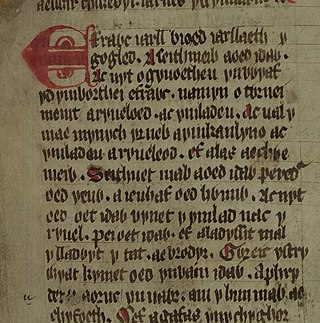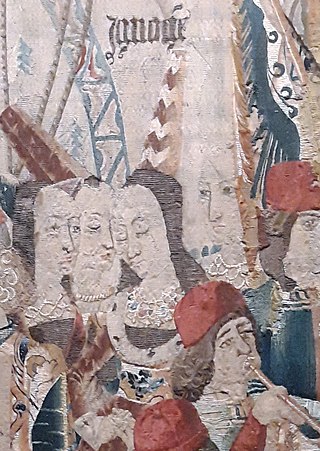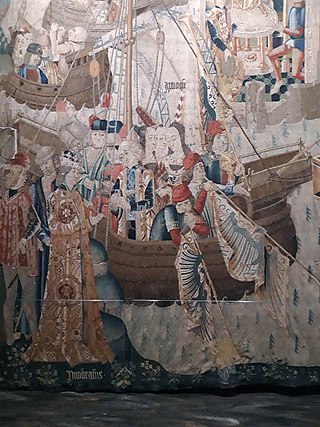
Geoffrey of Monmouth was a Catholic cleric from Monmouth, Wales, and one of the major figures in the development of British historiography and the popularity of tales of King Arthur. He is best known for his chronicle The History of the Kings of Britain which was widely popular in its day, being translated into other languages from its original Latin. It was given historical credence well into the 16th century, but is now considered historically unreliable.

Beli Mawr was an ancestor figure in Middle Welsh literature and genealogies. He is the father of Cassivellaunus, Arianrhod, Lludd Llaw Eraint, Llefelys, and Afallach. In certain medieval genealogies he is listed as the son or husband of Anna, cousin of Mary, mother of Jesus. According to the Welsh Triads, Beli and Dôn were the parents of Arianrhod, but the mother of Beli's other children—and the father of Dôn's other children—is not mentioned in the medieval Welsh literature. Several royal lines in medieval Wales traced their ancestry to Beli. The Mabinogi names Penarddun as a daughter of Beli Mawr, but the genealogy is confused; it is possible she was meant to be his sister rather than daughter.

Tasciovanus was a historical king of the Catuvellauni tribe before the Roman conquest of Britain.
Rivallo was a legendary king of the Britons as accounted by Geoffrey of Monmouth. He came to power in 817BC.
Sisillius I was a legendary king of the Britons as accounted by Geoffrey of Monmouth. He came to power in 753BC.
Ingenius is a legendary king of the Britons as recounted by Geoffrey of Monmouth's pseudohistorical work Historia Regum Britanniae, written c. 1138 CE. Ingenius was the fourth son of King Morvidus and the brother of Gorbonianus, Archgallo, Elidurus, and Peredurus. He came to power in 317BC.
Catellus was a legendary king of the Britons, as recounted in Geoffrey of Monmouth's work Historia Regum Britanniae. He came to power in 269BC.
Cherin was a legendary king of the Britons as recounted in Geoffrey of Monmouth's Historia Regum Britanniae. He came to power in 251BC.

Historia regum Britanniae, originally called De gestis Britonum, is a pseudohistorical account of British history, written around 1136 by Geoffrey of Monmouth. It chronicles the lives of the kings of the Britons over the course of two thousand years, beginning with the Trojans founding the British nation and continuing until the Anglo-Saxons assumed control of much of Britain around the 7th century. It is one of the central pieces of the Matter of Britain.
Arvirargus or Arviragus was a legendary British king of the 1st century AD, possibly based upon a real person. A shadowy historical Arviragus is known only from a cryptic reference in a satirical poem by Juvenal, in which a giant turbot presented to the Roman emperor Domitian is said to be an omen that "you will capture some king, or Arviragus will fall from his British chariot-pole".

Dionotus was a legendary king of Cornwall in Geoffrey of Monmouth's Historia regum Britanniae, an account of the rulers of Britain based on ancient Welsh sources and disputed by many historians. Dionotus succeeding his brother Caradocus, and was regent of Britain during the campaigns in Gaul of Emperor Magnus Maximus. The curious thing about this king is that the Welsh chronicles, which parallel most of Geoffrey of Monmouth's book, do not mention this king by name. However, Geoffrey uses Latin versions of Welsh names so he could be referring to Dynod, duke of Cornwall, or Anwn Dynod, Maximus's own son.

Peredur is the name of a number of men from the boundaries of history and legend in sub-Roman Britain. The Peredur who is most familiar to a modern audience is the character who made his entrance as a knight in the Arthurian world of Middle Welsh prose literature.
Lucius Tiberius is a Western Roman procurator or emperor from Arthurian legend, who is killed in a war against King Arthur. First appearing in Geoffrey of Monmouth's Historia Regum Britanniae, Lucius also appears in later, particularly English literature such as the Alliterative Morte Arthure and Thomas Malory's Le Morte d'Arthur. The motif of a Roman Emperor defeated by Arthur appears in the Old French literature as well, notably in the Vulgate Cycle.

Innogen is a character in the Historia Regum Britanniae and subsequent medieval British pseudo-history. She was said to have been a Greek princess, the daughter of King Pandrasus, and to have become Britain's first Queen consort as the wife of Brutus of Troy, the purported first king of Britain who was said to have lived around the 12th century BC. Her sons Locrinus, Camber, and Albanactus went on to rule Loegria, Cambria, and Alba respectively.
Mandubracius or Mandubratius was a king of the Trinovantes of south-eastern Britain in the 1st century BC.
Llefelys is a character in Welsh mythology appearing in the medieval Welsh tale Cyfranc Lludd a Llefelys. In the tale, Llefelys is king of Gaul while his brother Lludd is king of Britain. The tale appears in the Red Book of Hergest and the White Book of Rhydderch, the source texts for the Mabinogion, and embedded into various versions of the Brut y Brenhinedd, the Welsh adaptation of Geoffrey of Monmouth's Historia Regum Britanniae.

Alba Silvius was in Roman mythology the fifth king of Alba Longa. He was the son of Latinus Silvius and the father of Atys. He reigned thirty-nine years.
Pridwen was, according to the 12th-century writer Geoffrey of Monmouth, King Arthur's shield; it was adorned with an image of the Virgin Mary. Geoffrey's description of it draws on earlier Welsh traditions found in Preiddeu Annwfn, Culhwch and Olwen, and the Historia Brittonum. The shield is also named and described by Wace, Layamon, Roger of Wendover and Robert of Gloucester among other medieval writers, and it directly inspired the description of Sir Gawain's shield in Sir Gawain and the Green Knight.
Walter of Oxford was a cleric and writer. He served as archdeacon of Oxford in the 12th century. Walter was a friend of Geoffrey of Monmouth, who claimed he got his chief source for the Historia Regum Britanniae from him.

Pandrasus is the fictional king of Greece and father of Innogen in Geoffrey of Monmouth's pseudo-history Historia Regum Britanniae.








